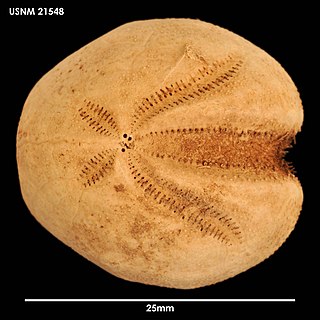
Melanopsis is a genus of freshwater snails with a gill and an operculum, aquatic gastropod mollusks in the family Melanopsidae.
The World Register of Marine Species (WoRMS) is a taxonomic database that aims to provide an authoritative and comprehensive list of names of marine organisms.

The Echinacea are a superorder of sea urchins. They are distinguished by the presence of a rigid test, with ten buccal plates around the mouth, and solid spines. Unlike some other sea urchins, they also possess gills. The group is a large one, with species found worldwide.

The Echinothurioida are an order of sea urchins in the class Echinoidea. Echinothurioids are distinguished from other sea urchins by the combination of a flexible test and hollow spines. The membrane around the mouth contains only simple plates, in contrast to the more complex mouth parts of their close relatives, the Diadematoida. They are nearly all deepsea dwellers.

Hyalina is a genus of sea snails, marine gastropod mollusks in the subfamily Pruninae of the family Marginellidae, the margin snails.

The Camarodonta are an order of globular sea urchins in the class Echinoidea. The fossil record shows that camarodonts have been in existence since the Lower Cretaceous.

Sterechinus is a genus of sea urchins in the family Echinidae. All living members of the genus are found in the waters around Antarctica but the first species described in the genus was a fossil and was found in Europe.
Aspidodiadema jacobyi is a small sea urchin in the family Aspidodiadematidae. It lives in tropical seas at great depths. Aspidodiadema jacobyi was first scientifically described in 1880 by Alexander Emanuel Agassiz, an American scientist.

Brisaster antarcticus is a species of sea urchins of the family Schizasteridae. Their armour is covered with spines. Brisaster antarcticus was first scientifically described in 1906 by Döderlein.
Brisaster fragilis is a species of sea urchins of the family Schizasteridae. Their armour is covered with spines. Brisaster fragilis was first scientifically described in 1844 by Düben & Koren.
Brisaster kerguelenensis is a species of sea urchins of the family Schizasteridae. Their armour is covered with spines. Brisaster kerguelenensis was first scientifically described in 1917 by Hubert Lyman Clark.

Brisaster latifrons is a species of sea urchins of the family Schizasteridae. Their armour is covered with spines. Brisaster latifrons was first scientifically described in 1898 by Alexander Emanuel Agassiz.

Brisaster moseleyi is a species of sea urchins of the family Schizasteridae. Their armour is covered with spines. Brisaster moseleyi was first scientifically described in 1881 by Alexander Emanuel Agassiz.
Brisaster owstoni is a species of sea urchins of the family Schizasteridae. Their armour is covered with spines. Brisaster owstoni was first scientifically described in 1950 by Ole Theodor Jensen Mortensen.
Brisaster tasmanicus is a species of sea urchins of the family Schizasteridae. Their armour is covered with spines. Brisaster tasmanicus was first scientifically described in 1974 by McKnight.
Brisaster townsendi is a species of sea urchins of the family Schizasteridae. Their armour is covered with spines. Brisaster townsendi was first scientifically described in 1898 by Alexander Emanuel Agassiz.
Brissalius vannoordenburgi is a species of sea urchin in the Family Brissidae. Their armour is covered with spines. Brissalius vannoordenburgi was first scientifically described in 2008 by Coppard.
Caenopedina capensis is a species of sea urchins of the Family Pedinidae. Their armour is covered with spines. Caenopedina capensis was first scientifically described in 1923 by Hubert Lyman Clark.
Brisaster is a genus of echinoderms belonging to the family Schizasteridae.









